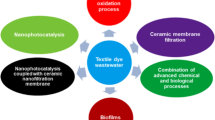Summary
Kodam et al. reported a 100% decolorization of the sulfonated azo dyes Reactive Red 2, Reactive Red 141, Reactive Orange 4, Reactive Orange 7 and Reactive Violet 5 by an unidentified bacterium, KMK 48. High effectiveness was attained within 36 h of incubation at room temperature and neutral pH. Optimum decolorization took place strictly under aerobic conditions, which is contrary to other well-documented reports. Thus, this microorganism seems to be potentially effective for bioremediation of textile-dyeing industry effluents.
Similar content being viewed by others
References
K-T. Chung S.E. Stevens (1993) ArticleTitleDegradation of azo dyes by environmental microorganisms and helminths Environmental Toxicology and Chemistry 12 2121–2132
W. Haug A. Schmidt B. Nörtemann D.C. Hempel A. Stolz H.J. Knackmuss (1991) ArticleTitleMineralization of the sulfonated azo dye mordant yellow 3 by a 6-aminonaphthalene-2-sulfonate degrading bacterial consortium Applied and Environmental Microbiology 57 3144–3149
K. Mechsner K. Wuhrmann (1982) ArticleTitleCell permeability as a rate limiting factor in the microbial reduction of sulfonated azo dyes European Journal of Applied Microbiology and Biotechnology 15 123–126
P. Nigam I.M. Banat D. Singh R. Marchant (1996) ArticleTitleMicrobial process for the decolorization of textile effluent containing azo, diazo and reactive dyes Process Biochemistry 31 435–442
F. Rafii W. Franklin C.E. Cerniglia (1990) ArticleTitleAzoreducatase activity of anaerobic bacteria isolated from human intestinal micro flora Applied and Environmental Microbiology 56 2146–2151
D.T. Sponza M. Isik (2002) ArticleTitleDecolorization and azo dye degradation by anaerobic/aerobic sequential process Enzyme and Microbial Technology 31 102–110
N.C.G. Tan F.X. Prenafeta-Boldú J.L. Opsteeg G. Lettinga J.A. Field (1999) ArticleTitleBiodegradation of azo dyes in cocultures of anaerobic granular sludge with aerobic aromatic amine degrading enrichment cultures Applied Microbiology and Biotechnology 51 865–871
Q.X. Yang M. Yang K. Pritsch A. Yediler A. Hagn M. Schloter A. Kettrup (2003) ArticleTitleDecolorization of synthetic dyes and production of manganese-dependent peroxidase by new fungal isolates Biotechnology Letters 25 709–713
T. Zimmermann H.G. Kulla T. Leisinger (1982a) ArticleTitleProperties of purified orange II azoreductase, the enzyme initiating azo dye degradation by Pseudomonas luteola Bioresource Technology 49 47–51
T. Zimmermann H.G. Kulla T. Leisinger (1982b) ArticleTitleProperties of purified orange II azoreductase, the enzyme initiating azo dye degradation by Pseudomonas KF46 European Journal of Biochemistry 129 197–203
Author information
Authors and Affiliations
Corresponding author
Rights and permissions
About this article
Cite this article
Kodam, K.M., Soojhawon, I., Lokhande, P.D. et al. Microbial decolorization of reactive azo dyes under aerobic conditions. World J Microbiol Biotechnol 21, 367–370 (2005). https://doi.org/10.1007/s11274-004-5957-z
Received:
Accepted:
Issue Date:
DOI: https://doi.org/10.1007/s11274-004-5957-z




